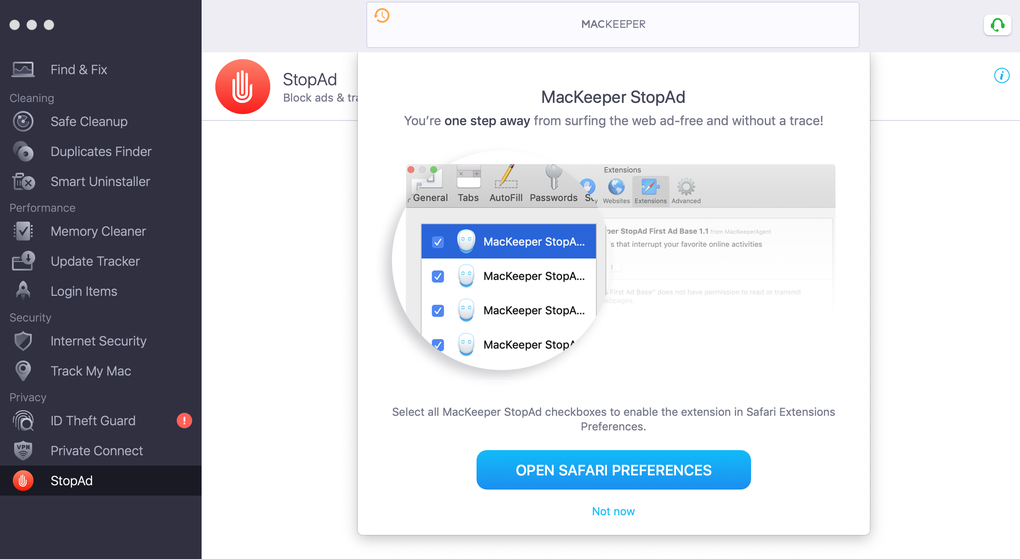
- #Mackeeper apple for free#
- #Mackeeper apple install#
- #Mackeeper apple update#
- #Mackeeper apple manual#
- #Mackeeper apple software#
Click on it and enter your admin password. Notice the padlock in the window is up there on the left, rather than down the bottom. Go to Applications > Utilities > Keychain Access.app and double click on it. The last item above will require removal in Terminal or turning on of invisible files in the GUI (various 3rd party apps can do this, including my own DetectX and FastTasks 2).Ĥ. ~/Library/Application Support/MacKeeper Helper ~/Library/Preferences/.plistīe careful not to delete the wrong files: only those that have got the words ‘zeobit’, ‘MacKeeper’, ‘911’ or ‘911bundle’ should be trashed.ĭue to recent changes in MacKeeper, the following files should also be searched for and removed: Then trash any and all of these that you find: If you are using Snow Leopard or Leopard, just click on the little ‘ Home‘ icon in the Finder sidebar and navigate to the Library. Choose ‘ Library’ from the menu (yes, this is a different Library folder from the one you were just in). If you are using OS X Lion 10.7 or later, use the ‘Go’ menu in Finder’s menubar and hold down the ‘option’ key.

Library/LaunchDaemons/.AntiTheft.daemonģ. Still in Library, look for and trash any of these you find in the same way: Look in the Application Support folder for the folder inside it called ‘MacKeeper’:Ģ. From the sidebar in any Finder window, choose your hard disk icon and go to your Library folder. If you have any doubts, post a question in the comments.ġ. For that reason, go slow, read carefully and don’t do anything if you’re not sure what you’re doing. However, bear in mind that the onus is on you to follow the instructions to the letter. They’ve been refined over the years by many people who contributed in the hundreds of comments that follow this post and have been proven to work without exception. If you need to remove MacKeeper manually then follow these instrutions carefully.
#Mackeeper apple update#
Follow the instructions, but consult my post here for the most recent update to the list of MacKeeper filepaths. Please note also that the list of filepaths below is somewhat out of date.
#Mackeeper apple manual#
The only people who should really consider the manual option are those that are running versions of macOS that are too old to run DetectX. Just download the app, run it, remove MacKeeper and be on your way.Īfter several years of testing and refining my app’s removal procedure, I now recommend using it even for proficient users as it is simply faster, more reliable and less prone to error than doing it any other way. You do not need to sign up to anything, subscribe to anything or give anyone your email address.
#Mackeeper apple for free#
This is a shareware that can be used for free 😀. If that sounds like you, then the easiest way to uninstall MacKeeper is to use my app DetectX. You are now ready to uninstall MacKeeper.Īs I’ve been involved in helping people uninstall MacKeeper for over 5 years, I eventually got round to the task of automating the process so that folks who were not that technically proficient with computers could take advantage of the information on this page. If you have anything in the Trash, empty it now before you start.

If you have any disks connected to your mac, including Time Machine, eject them before you start the uninstall procedure. You should also check whether any of your personal files are stored in /Documents/MacKeeper Backups. If you have used MacKeeper’s encryption feature, be sure to unencrypt before you uninstall MacKeeper. If you have installed MacKeeper and wish to remove it, read on. 17:48:00.946 : () This service is defined to be constantly running and is inherently inefficient.

macOS provides the following warning about MacKeeper: macOS doesn’t like MacKeeper much either.
#Mackeeper apple software#
It seems, then, that MacKeeper thinks macOS, freshly installed, is a poor piece of software engineering, but the feeling is mutual.
#Mackeeper apple install#
When I ran MacKeeper’s free trial version on a brand new clean install of macOS, it told me that my system was in ‘serious’ condition and that I needed to buy MacKeeper in order to solve all my problems. This post itself was first published in September 2011, and has since received over 2 million hits from people wishing to uninstall MacKeeper from their computers. MacKeeper is one of the most infamous pieces of software on the macOS platform. If you’re unfamiliar with the reputation of MacKeeper but have come here because you downloaded it – or it downloaded itself after you were inadvertantly redirected to some unwanted website – and are now wondering whether you made a mistake, let me present you with a few facts.


 0 kommentar(er)
0 kommentar(er)
